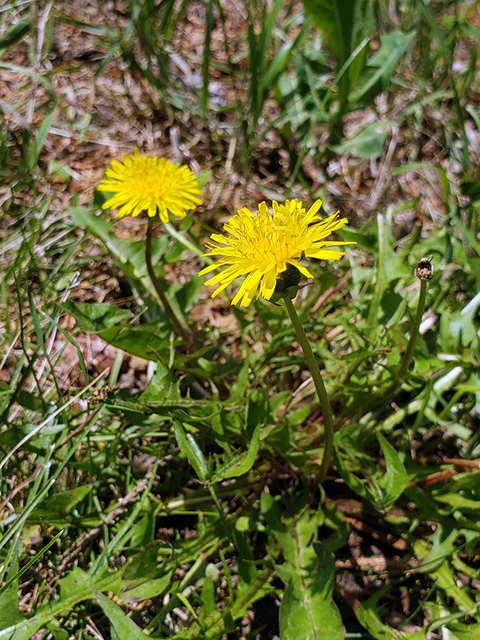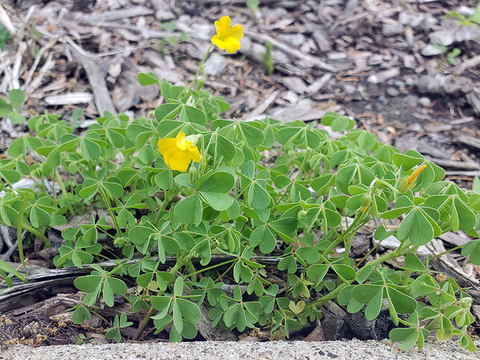Whether for survival or fun, foraging can be a great way to supplement your diet with plants that are not only delicious but can also be healthy.
Foraging in your own backyard
Although it may be illegal in some cities in Minnesota to forage in parks and woodland areas, foraging on private property is legal. If you don’t have the time or ability to wander around the woods in search of elusive treats, sometimes you can find plants and fungi in your own backyard to add to your everyday meals.
While I was walking through my backyard the other day, I found lots of dandelions in bloom. Usually considered a weed, dandelions are one of the easiest edible plants to find and identify.
When foraging for weeds and other plants and fungi it is important to note that these plants can grow next to areas where the soil and water may not be clean due to chemicals from roadways, buildings, or weed removal. Chemicals can have negative effects on your health and it is best to avoid foraging plants where they may have been used.
One way to ensure toxin-free dandelions is to allow them to grow in your own yard, and don't apply toxic chemicals to the plants. When I was a kid, instead of spraying to remove dandelions, I would collect and then sell the blooms to the local winery to be used for dandelion wine.
Dandelion (Taraxacum spp.)
Two species of dandelion are most prevalent in Minnesota, the common dandelion (Taraxacum officinale) and the red-seeded dandelion (Taraxacum erythrospermum). Native to Europe, they were brought to the Americas in the 1600s by settlers and were grown in gardens for edible and medicinal purposes.
Dandelions' status changed from food to weed when the culture of lawn grooming became a symbol of wealth and status. The standard of a manicured lawn was disturbed by dandelion flowers, so they were removed.
Although dandelions offer nectar for pollinators early in the season and do not compete with natives, the culture of weed removal continues to this day.
Easily detectable by their bright yellow flowerhead and lance-shaped leaves, harvesting dandelions can be worry-free. Although there are dandelion look-alikes in sow thistle and cat’s ear, both lookalikes are also edible. For a quick way to differentiate the dandelion from its lookalikes, the dandelion has a hollow stalk and a single flower head.
The three parts of the dandelion that are edible are the flower, leaves, and roots. All of these parts are full of nutrients such as vitamins A and C, iron and fiber, and have been used for many traditional medical remedies.
- The flower of the dandelion when harvested immediately pre- or post-bloom has a sweet taste many compare to honey that can be used in the making of wines and teas. You can mix the petals in with pancake batter, cookie dough and cakes, or fry them whole in a fritter.
- The mature flowerhead, while still edible, will become bitter as it ages.
- The leaves are best harvested when the flower is young, before it blooms, and can be eaten alone, as seen in some of the top kitchens around the world, mixed into a pesto, or used to garnish a baked potato.
- The leaves have a slightly bitter taste comparable to radicchio, which becomes stronger as the plant grows older, but bitterness can be reduced through cooking.
- The roots may be tough to eat raw, but when dried and roasted can be a great coffee replacement, as a bitters ingredient, or added to soup.
While there are numerous recipes for dandelion, my personal favorite is adding them to lemon bars.
Wood sorrel (Oxalis spp.)
Another warm-season quick snack with a sour flavor you can find in almost any yard is wood sorrel. There are several species of wood sorrel in Minnesota including southern wood sorrel (Oxalis dilenii), common wood sorrel (Oxalis montana), and violet wood sorrel (Oxalis violacea). All are edible.
Found in full sun to partial shade, wood sorrel is a trefoil plant (three-leaved) with each leaf forming a heart-like shape.
This plant is also identified by its five-petaled flowers. Wood sorrel flowers are usually yellow or white but have also been seen in different shades of violet.
This plant is mostly native to North America and as such has been used for thousands of years by many different Indigenous American groups. Some species may have been introduced.
Both wood sorrel and clover have a similar appearance, but wood sorrel leaves look like hearts, and clover leaves are rounded. When blooming, clover flowers are significantly different from wood sorrel flowers, having multiple pink or white flowers that give the appearance of a sphere.
All of the wood sorrel plant is edible, and if you do mix it up with clover, don’t worry, your bite will taste more like vanilla than citrus, but both are edible.
Although this is one of my favorite forageable snacks, make sure to only eat it in moderation. Wood sorrel contains oxalic acid, which, when combined with other minerals in our bodies, turns into oxalates. Oxalates are also found in foods like spinach and other leafy greens and are healthy if managed correctly. For a healthy oxalate level, it is recommended to stay under 8g (13-20mg/g, based on 200-300mg/day) of wood sorrel per day, but this number can vary and it is best to consult your physician if worried. If not managed correctly, oxalates can lead to kidney stones and other potential issues.
Although wood sorrel can be used in teas and soups, I think it tastes the best when left raw.
Common purslane (Portulaca oleracea)
Purslane is another weed that can be a delicious addition to a meal. Purslane was primarily used as a food source before the manicured lawn movement and is used in many traditional recipes around the world.
In Minnesota, there is one primary species of purslane, Portulaca oleracea, which grows close to the ground (prostrate), with a red stem, rounded succulent leaves, and small yellow, red, pink or white flowers. Although common purslane prefers dry and full sun environments, this plant will grow in almost all conditions.
Purslane has one toxic lookalike, prostrate spurge (Euphorbia maculata). To distinguish them from each other, simply break the stem. A prostrate spurge stem will have a milky sap inside, while common purslane will not.
Once common purslane has been identified, all parts are edible, although the leaves and stem are used most commonly in cooking.
Purslane adds a lemony/salty bite to any recipe and has been proven to contain large amounts of potassium, magnesium and omega-3 fatty acids that can aid the cardiovascular system.
Although this plant can be nutritious, much like wood sorrel, eat it sparingly as it also contains oxalic acid. To maintain a healthy oxalate level, it is recommended to eat less than 23g of purslane a day (6.71-8.69mg/g based on 200-300mg/day). The amount of consumable purslane per day may change based on each individual as well as their oxalate needs and it is best to consult your physician if worried. Oxalates can lead to kidney failure, kidney stones, and other issues if not managed correctly.
One of my favorite uses for purslane is in tzatziki, adding a zesty flavor to the Greek sauce.
Adding weeds to your diet can be as easy as weeding your yard. Although the yard is a great place to start foraging, there are many other edible plants and fungi in Minnesota that can be found nearby. From the honey-like taste of dandelion flowers to the citrusy/salty taste of woodsorrel and purslane, Minnesota is a great place for foraging!
A great resource for learning more about foraging in Minnesota is the Minnesota Harvester Handbook.
Foraging on public lands
Foraging on many public lands is illegal and is controlled for reasons such as environmental protection. In order to determine if foraging locally is legal, contact your county parks system for laws regarding foraging in the region. For national and state parks and lands, refer to their regional offices or the Department of Natural Resources (DNR) for information regarding foraging.
Along with the legal protection of ecosystems, when foraging it's best to only take 10% of what you find so that the plant has a chance to repopulate and continue to provide food for any plant or wildlife that rely on it.
Also, be careful not to spread invasive species. Invasive species compete with Minnesota native plants and can cause damage to our soil and water quality. Here's more information from the Minnesota DNR on how to prevent the spread of invasives while foraging.
Harris, J. How To Eat A Low Oxalate Diet. Kidney Stone Evaluation And Treatment Program. Retrieved May 30, 2022, from https://kidneystones.uchicago.edu/how-to-eat-a-low-oxalate-diet/
Joan C. Yang, & Loewus, F. A. (1975). Metabolic Conversion of L-Ascorbic Acid to Oxalic Acid in Oxalate-Accumulating Plants. Plant Physiology, 56(2), 283–285. http://www.jstor.org/stable/4264146
Poeydomenge, G & Savage, Geoffrey. (2007). Oxalate content of raw and cooked purslane. Journal of Food, Agriculture and Environment. 5.
Stevens, H. (2021, March 9). Common purslane, weed it or reap? MSU Extension. Retrieved May 30, 2022, from https://www.canr.msu.edu/news/common_purslane_weed_it_or_reap#:~:text=It%27s%20succulent%20nature%20enabling%20it,to%20consider%20it%20a%20weed
Taylor, D. Common Yellow Wood Sorrel (Oxalis stricta). Plant of the Week. Retrieved May 30, 2022, from https://www.fs.fed.us/wildflowers/plant-of-the-week/oxalis_stricta.shtml
Uddin, M. K., Juraimi, A. S., Hossain, M. S., Nahar, M. A., Ali, M. E., & Rahman, M. M. (2014). Purslane weed (Portulaca oleracea): a prospective plant source of nutrition, omega-3 fatty acid, and antioxidant attributes. TheScientificWorldJournal, 2014, 951019. https://doi.org/10.1155/2014/951019
US Department of Agriculture. (2019, January 4). Dandelion greens, raw. FoodData Central. Retrieved May 30, 2022, from https://fdc.nal.usda.gov/fdc-app.html#/food-details/169226/nutrients




